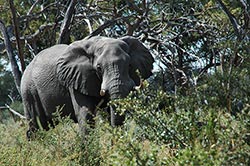
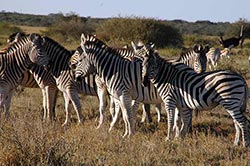
AFRICA ONE - INTRODUCING BOTSWANA
AFRICA TWO - GABORONE
AFRICA THREE - BUSHMAN TERRITORY
AFRICA FOUR - A WILDERNESS FULL OF ANIMALS
AFRICA FIVE - SNAKES
AFRICA SIX - ELEPHANTS
AFRICA SEVEN - MUSIC
AFRICA EIGHT - LIONSs
AFRICA ONE - INTRODUCING BOTSWANA
Hi all,
Many of us have access to extraordinary experiences these days, and we are enriched by our connection to the variety and breadth the world has to offer when we hear of experiences others have that we haven't had a chance for. Maybe it even promotes peace between disparate peoples. In that spirit, we plan to write an occasional (weekly?) vignette of our May, 2007 trip to Botswana, Africa, and send it with a couple of pictures. If you'd rather not get these, we understand completely, but here's the first one.
We spent April 22 - May 24. 2007 in Botswana, Africa with a short trip to Zimbabwe. The first seven days we spent in the capital and largest city, Gaborone which is about twice the size of Boulder, CO (pronounced like Spanish, "Ha-ba-RO-ni) visiting with marimba bands, and recovering from jet lag. It was definitely Africa. At the public park in Gaborone, there are warthogs, impala, kudu, crocodiles, and monkeys, not chipmunks, bicycles and joggers.
Then we spent 15 days camping and driving through the Botswana wilderness, the Kalahari Desert to the Zambezi River. We saw 40 new animal species and many more new birds than that. We say many towers of giraffe, crossings of zebra, crashes of rhinoceros, congregations of crocodiles, obstinancies of buffalo, sieges of herons, cackles of hyenas, a prowl or a leap (of one) leopard, a pride (of two) lions, flocks (of 2-4) ostriches, slithers of snakes, swarms of termites, herds of many different kinds of antelope, troops of baboons, cete of badgers, a mute (of one) hare, many bloats of hippopotami, barrels of monkeys, a parliament (of one) owl, murmations of starlings, committees of vultures, and many parades of elephants. Thousands of animals in their native habitat!


The last week we spent in the very north tip of Botswana and the very western tip of Zimbabwe at Victoria Falls and in Kasane, Botaswana.
The trip was rich beyond our wildest dreams, and best of all it makes us appreciate home, each other, and all our friends here more than anything in our lives. Regardless of how much Max isn't wild about traveling, he is the best traveling companion I can imagine. And then there's me - fearless and eternally curious about exploring new people and places, so we were a good pair.
We met many different kinds of people - bushmen hunter-gathers one of whom accompanied the entire wilderness portion of the trip, mekoro (dugout canoe) polers and guides, traditional village dwellers, basket makers, marimba players, singers and dancers, a surly colonial British guide, and in general very kind every-day people having ordinary lives in this amazing continent, Africa.
We played with a couple of marimba bands, played dulcimer for bushmen villagers, and learned that the most common Botswanan traditional music is vocal with dancing We crossed the Zimbabwean border into Victoria Falls and loved these Zimbabwean people as well. We'll get into more detail of each part of the trip in future vignettes.
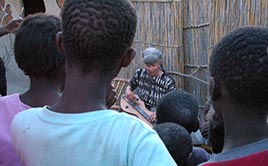
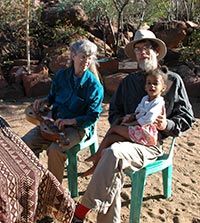
First, a little about the nation of Botswana. It's in the center of southern Africa, bordered clockwise by South Africa, Namibia, and Zimbabwe. 85% of the country is the Kalahari dessert, no coastline, and it's fall there. Leaves are turning, the days are short, the nights long, and it's not over 85 in the daytime, around 50 at night. Economically and politically Botswana is a recent success story in Africa. It has a history of benevolent, non-corrupt chiefs and now presidents (the current president is humble enough to have been seen in the grocery store doing his own shopping!) Botswana gained its independence in 1966 non-violently, probably because the British didn't see anything but desert and so granted independence without much resistance. Botswana hasn't ever been involved in major military activities or wars. A couple of years after independence, in the late '60s, diamonds were found, and Botswana is now the world's largest gem-quality diamond producer. A good amount of revenue comes to the Botswana government (32% of GNP) from the diamond industry, and the government uses this to create infrastructure including paved roads, free public education even through college, health care, development of industry and investment, and grants to people who have creative ideas that might be beneficial to Botswana and want some capital to implement them. Botswana was the world's fastest growing economy from 1966 to 2005. The diamonds are predicted to run out in approximately 35 years, and in the meantime the government is working to create alternative sources of income - the cattle and tourism industries figure prominently in the plans.
Botswana's biggest challenges are (1) the HIV crisis - antiretroviral drugs and condoms are free, and there is lots of work on this problem going on. (2) How to preserve traditional peoples and old cultures and modernize at the same time without losing the good parts of each realm. The conflicts over the government's moving the Bushmen (San) from the Central Kalahari are central here.
So that's the overview. All isn't perfect, but Botswana is a model of what this continent of vast natural resources and strong soulful people could be with good leadership.
Next: highlights from the time in Gaborone.
Please let us know if you prefer not to continue to get these Africa stories.
It's a pleasure to share them with you if you want - our own effort to share
the world we live in and it's peoples in another way than in the scary newscasts
we hear daily. That old people-to-people exchange model worked well for us!
We spent a week in the capital city, Gaborone playing marimba and experiencing the "big" city life and visiting with our friend Doug Cosper.
Doug? If Bonnie is the person who made all this necessary, Doug is who made it possible. He is a Nederlander I ran into at a Christmas party. In the whatcha-been-up-to discussion, he said he was to be teaching in Botswana for 4 1/2 months. I drooled a little too realistically and he said, "Why don't you come down while I'm there. I'll do what I can to pave the way for you." Dangerous words. He provided us a place to land and take jet-lag naps, took us to buy a cell phone (who would have thought we would learn to text-message for the first time in Africa), and sent us on our way with the names and numbers of taxi drivers Abu and Easy programmed into the phone.
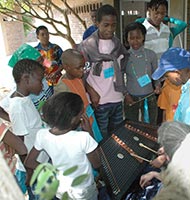
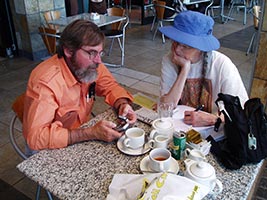
The way the taxi system works is that drivers have cell phones and you give them a call, they come in 4-5 minutes, take you anywhere you want to go and charge you less than $4 to do so. Abu from Kenya was our favorite, has a good sense of humor and a very sweet personality. Another favorite was named Easy. When we called (or texted) these guys we would say, "We're Mr. Doug's friend, can you take us to …." Abu texts back, "Yes, my dear, I can come." Other cool taxi driver names included "Mr. Thank You" (that's what his name translated to in English, he said) and "Gift. "
The monetary currency is called "pula," which means rain. Many things are named "Pula" this and "Pula" that. This lets you know how important the concept of rain is to this dry land. We experienced a total of one hour of rain - torrential and then gone as if it had never arrived. This while talking on Doug's patio and drinking South African wine. In much of the country, there are no permanent water sources, and so the animals and people migrate from one water hole to another, following seasonal rain patterns. This is the cause of animal migrations in Botswana.
A big draw of Botswana for us was Alport Mhlanga, a grand old man of the Zimbabwean marimba music that we play. He is about our age, and twenty years ago he emigrated from the Kwanangoma College of Music in Zimbabwe to Maru-a-Pula (Clouds of Rain) high school in Gaborone where he teaches every sort of music from Western orchestral to African marimba. It was lovely to hear him play - it's delicate, improvisational, dynamic. Very musically educated, skilled, talented soul. We spent lots of our time in Gaborone with him, learning tunes, playing with and for his marimba band. Max taught his group "The First of March," a marimba piece Max wrote. I played dulcimer for them and told them probably more than they ever knew existed about Irish and American traditional music and instruments. We found another marimba band in Gaborone, also traceable to the Zimbabwean marimba scene that is the source of this marimba music we play.
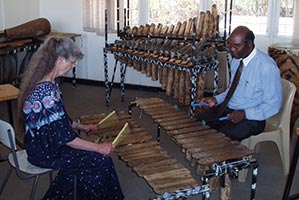
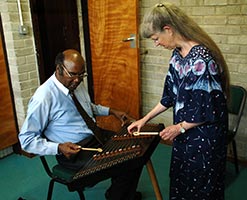
We saw the rehearsal of the first of many traditional Botswana chorus and dance groups, and a black gospel concert.
We and about a hundred vervet monkeys attended a surprise going away party for Doug given by his students and sampled the lauded Botswanan beef in the form of braii (barbecue). Well … it ain't Texas beef, says this ex-Texan. The teenaged girls were fascinated with my long hair and set about putting it in corn-rows so they could play with it. I took a cue, and anywhere we were and people were staring at my hair, I invited them to touch it. Made lots of friends this way. Almost as effective as playing music for them. A musical moment I'll not forget soon for me was telling the students the story of the song Amazing Grace and then singing it with them. (I'm sure you all know this history since there's been a movie about it called "Amazing Grace," but if not, it tells of a British slave trader who saw the error of his ways in the middle of a voyage and returned his human cargo to Africa.)
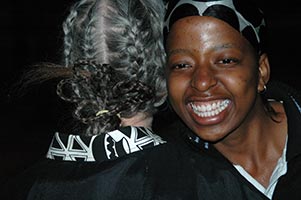
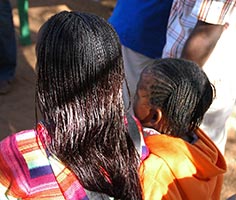
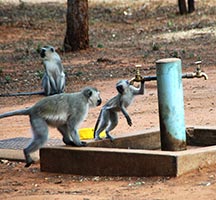
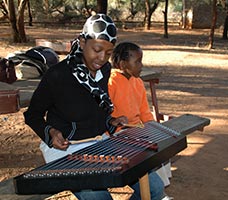
We were glad not to be trying to drive - walking is hard enough. If you are crossing a road and don't see any cars about to run over you, you must be looking the wrong direction, the direction from whence they would be coming in the US! And both of us who have crack senses of direction here in the northern hemisphere were never able to develop any sense of direction either in the city or in the bush. We were forever standing on a corner, even in a city, compass and map in hand trying to get oriented. I think it's because the sun is low in the north, there are few topological features, and everyone drives on the wrong side. Very disorienting. Our guides never let us out of their sight - apparently they have had this experience with other northern hemisphere travelers and they took the job of not losing their charges seriously. More than once they teased us after a walk by asking, "Which way is camp?" and we invariably got the wrong answer.
The city park in Gaborone is a game reserve, and we saw our first game there - some kudu and impala (members of the antelope family), warthogs, and monkeys. Pretty different from our city parks which sport joggers and squirrels.
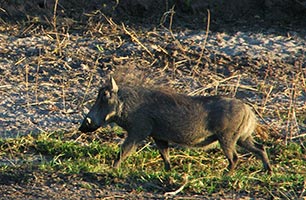
So that's Gaborone. Next we'll start on our cultural and wilderness trip from south to north in the country. Remember that means it gets warmer as you go north - yes the equator is north!
AFRICA THREE - BUSHMAN TERRITORY
Now we're into our second week in Botswana, and our first stop out of Gaborone is a traditional Tswana village recreation designed to teach people about the old traditional ways. We leaned how to "throw bones" (which said, incidentally, that our trip would be charmed, but we already knew that). We watched some traditional dance and singing and tried to learn a song and I played dulcimer for half a dozen people to complete the cultural exchange. We learned that even Botswanans with a PhD believe in witchcraft. We had a traditional dinner (beef stew, butternut squash, sautéed spinach, biscuits, and coleslaw made with purple cabbage), slept in a lovely traditional thatched roof "rondaval" - the round huts you always see in pictures of Africa (romantic, simple, no electricity.) The evening fire and rondaval inspired a bit of composing on mountain dulcimer while Max slept. The thatched roofs make these structures cool and quiet. This village is one of the projects to make Botswana a more interesting place and preserve it's traditional culture, conceived by someone with a vision and funded by grants from the government.
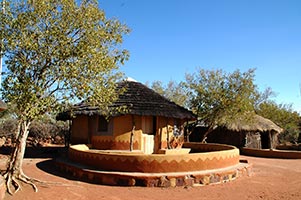
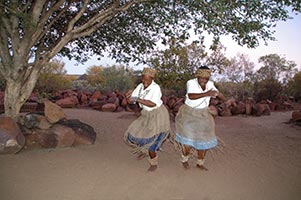
On to the Kalahari - the next day we drove deep into Bushman territory and picked up three Bushman guides to camp with us for a few nights, Oakantsi, Chamca, and Doux. They "knew the bush" as it's said. They showed us how to make fire without matches - oh boy we don't have to carry three different kinds of fire starter in our pack emergency kits any more! They showed us innumerable plants and told us their uses, usually digging up their roots. The Bushmen were like badgers digging in the sand, and maybe a yard down in the sand they would find a yard-in-diameter tuber which contains enough moisture to sustain goats during the long no-water seasons. They showed us how to make string with a yucca-like plant and then how to make an animal trap out of the string. We made the trap, baited it, and then retreated twenty feet away and waited all of 5 minutes until a bird was about to loose its life in it. We aborted the hunt because we didn't need it to eat, and we're not supposed to kill wild animals in a national park. The Bushmen identified tracks of many animals and told us the stories or what the animals were up to - "here is where the two male lions we heard roaring last night were fighting over the female - see the hairs on this bush where they passed under it? The fight happened here - see how the sand is disturbed?" And indeed, we could see the tracks, hairs and the fight scene - at least after it was all pointed out. The Bushmen collected the 4-5 hairs for luck in their own next hunt. We wanted some, but I think they were much more important to the hunt than to our scrapbooks
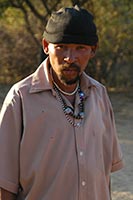
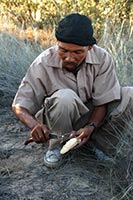
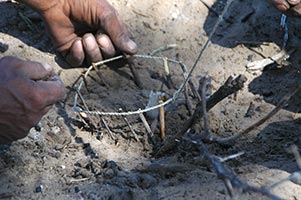
An auditory delight was listening to Oakantsi, Doux, and Camca speak the click bush language. The Bushmen are small, about 5 feet tall and lean. They are quick to work together on heavy or difficult tasks. We heard and had translated several Bushman tales of how the sun was made and about the scrub hare who seems to fill the same niche as our coyote mythology.
The topography in the Kalahari is … well .. not topographical. The land is so flat that it's remarked on and it always has a name when you come upon a rise. It's so flat, that if you're lost, it's actually a pretty good way to get found to climb on top of the Toyota Land Cruiser from whence you can see a full 360 degrees to all horizons.
During our two days in the Central Kalahari Game Reserve (historical and recently re-granted home of the Bushmen tribes, also called the San and Kosi peoples) we saw our first profusion of game - 30 hartebeests (in several herds), steenboks (usually alone), springboks, ground squirrels (look a lot like our own), ostriches (in groups of 2-4 - dust bathing), gemsboks (which was certainly the prettiest antelop-y animal - very large, big straight horns and dramatic markings - can survive without water by eating tubers and grasses), impalas (which are Botswana's most common mammal), wildebeasts, jackals, a yellow cobra (yikes!) and bunches of scrub hares and their burrows.
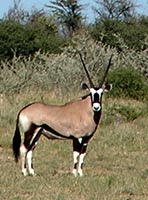
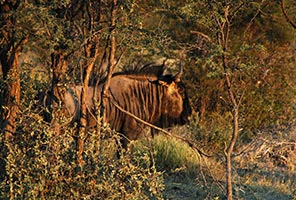
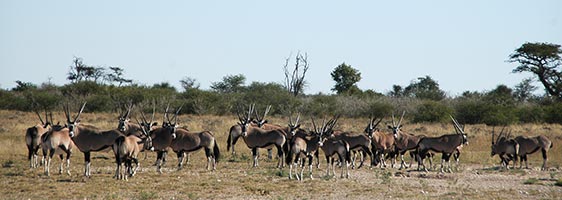
Max presided over several good gawks at the austral hemisphere skies, at least before we started having puff adders (a very poisonous snake) and elephants under foot all night. In Setswana, Venus is known as the "waiting for dinner star". We had stunning rises of the full moon over the Kalahari, then a few days later dark skies with the southern cross, Orion, and the dipper upside down, Scorpius directly overhead at midnight, and the Magellanic Clouds.
After a few days, we regretfully delivered two of the Bushman guides back to their village, Kudwane, and spent the next night in another traditional Tswana village in another rondaval with chickens and burros for neighbors. A very noisy night, which seems to be the norm worldwide in small villages where stock animals are common. I remember the phenomenon in Latin American villages - only the animals spoke Spanish instead of Setswana, of course. There was a pottery group meeting on the property where we were staying. They created pots and fired them all night in a pit using cow dung. The pots were finished in the morning when we rose.
Our next stop was the Khama Rhino Sanctuary - more on that in the next installment.
AFRICA FOUR - A WILDERNESS FULL OF ANIMALS
Max and I have talked and talked about our experiences with all the big wild animals we experienced in Africa and wondered how to write about them. To put into words the experience of feeling like the minority species in a vast wilderness of big animals, the habits of which we understood only vaguely, is indeed a daunting task.
In our back yard here in Colorado we have deer weekly, elk yearly, have had several bears over the 18 years we've lived here and a similar number of bobcats. Seven moose have wandered over from the western slope of the Continental Divide where they were re-introduced a decade ago. We feel like we live in something close to a wildlife preserve, at least for the US.
Here's a new frame of reference about animals: In Africa we saw several hundred big animals almost daily. Even in Gaborone, the City Park sported kudu (large antelope-family members), impala, warthogs, monkeys by the hundreds, etc. In the northern Botswana village where we spent our last week we could wander across the lawn of our lodge and dangle our toes in the Zambezi River if we weren't afraid of the several crocodiles lurking in the reeds. We were worried they'd like our toes, so we didn't dangle.
Here's a 12 foot croc we met:
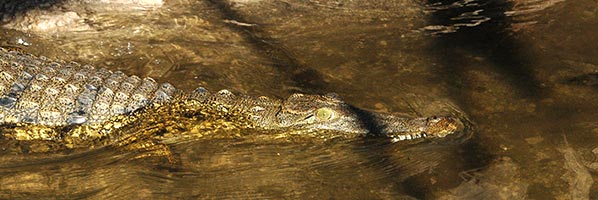
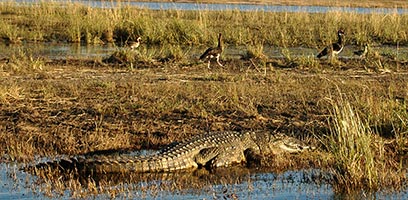
In the mornings we found hippo tracks on the lodge lawn, which was fitting since the lodge was named Kubu Lodge, a word for hippos. And as we got on a plane to begin our trip back to the US, half a dozen elephants were below us waving goodbye with their trunks. There simply are huge herds of giant animals everywhere.
The Botswanan Government is serious about preserving habitat for these animals and the visitors who want to see them. 17% of the land is in national parks and game reserves with another 20% devoted to wildlife management areas. This amounts to thirty-seven percent of the landmass of the country sporting wildlife the likes of storybooks.
Here's a few things we learned about these animals: for the most part they aren't much interested in people. We aren't food as far as the local predators have determined, and it's been several animal generations for most of the herbivores since humans hunted them much so between these two facts they aren't very interested in us, either as food or threat. While Bushmen are allowed to hunt a specified number of each species, (maybe 2-20 per species per year, the quotas depending on the species) and there are a few game reserves where hunting safaris exist, we didn't experience either situation first hand. We are led to believe the Bushmen don't hunt much these days and fewer and fewer reserves find hunting safaris to be their best financial approach to sharing their game resource with travelers.
Anyway, if we didn't threaten the animals or their young, they seemed indifferent to we humans, we were told. Nevertheless, many of them are huge, obviously could inflict great harm on humans if they were of mind, and how do we know when they are threatened? Here's where a guide comes in - licensed guides receive extensive training during the licensing process about animal behavior, and the native Botswanan guides, many of them, grew up around the animals. Our Tswana mekoro poler, Goldun, knew that the elephant we came upon while tracking game on foot was not just cooling himself by flapping his ears which is what most elephant ear flapping implies. This particular flap indicated that we were too close and we should leave. It was coupled with the elephant's walking towards us, not running, not doing anything we novices could interpret as hostile, just walking. Elephants are big and have long legs so their ambling stride moves them quickly from point A to point B. We walked quickly away, and the elephant returned to eating. Incidentally, Goldun seemed to speak elephant-ese more fluently than English, for which we were grateful several times.
Later in our game walk Goldun noted, "Impala tracks, very fresh." With that he followed the tracks and within 10 minutes was showing us the very impala herd of the fresh tracks. Then he explained to us about a particular disturbance in the sand, "elephant pillow. Elephant is lie down here to sleep." About a grove of coconut palms where there were many, many fresh leopard tracks, Goldun explained, "baboons is love to eat coconuts and leopard is love to eat monkeys." Presumably the leopards pace below the coconut palms waiting for the monkeys to descend.
Predators we saw were lions and leopards (the most common predator in Botswana.) The Bushmen say the predators aren't tasty, so the objects of the Bushmen's hunting are herbivores, mostly various antelopes - impala (the most common mammal in Botswana) kudu, gemsbok, springbok, steenbok, hartebeests, lechwe, sable, etc.
Hippopotamus are the animal credited with the most human deaths. We were left to our imaginations about what they do that causes these human deaths besides that they are gigantic, have huge mouths with big teeth, and when on land don't like anything to get between them and the patch of water they call home. The hippos live in the water during the daytime with only their noses and eyes above water and occasionally they yawn (or "put on a big smile for the photo," as one guide termed the wide open hippo mouth that we've all seen in photos). They come out of the water at night to graze on land. Once during the daytime, we found a small band of hippos out of the water sleeping (unusual??) - they resembled giant water balloons or piles of mashed potatoes when lying on their sides. I was amazed by how flat these huge round creatures become when sprawled next to the water working on their suntans. It's as though they have no bones or hard infrastructure to their bodies.
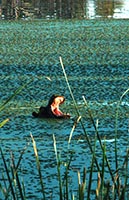
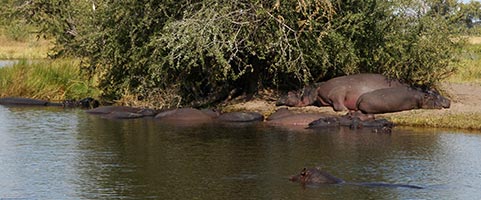
There's so much more to say about the animals, but there's you a beginning. We'll probably tell several more stories about animals. We couldn't agree with Chief Seattle more when he wrote in a letter to the United States President in 1855: "If all the beasts were gone from the earth, man would die from great loneliness of spirit."
I read this, ironically, in The Wilderness Family by Kobie Krüeger, wife of South African Afrikaans Ranger Kobus Krúeger. The book tells of many wildlife experiences one might expect in the back country of a South African National Park - great read - what a life for kids.
Everybody's favorite reptile. We don't get much venomous snake activity in the Southwestern USA, just an occasional rattle snake. It's a nasty bite but seldom fatal. Once, years ago, Bonnie and I went for an evening swim in a Texas river. On our way back to the car a Water Moccasin slithered right in front of us and into the very river we had just left. Africa is a bit different.
A vehicle coming the other way hails us to stop. They had just seen a Black Mamba go into a large bush "that one, right there" and wanted to warn us. Thanks - we rolled up the windows on that side of the car, looked but didn't see it. It was a very dense bush. Later we saw a framed Black Mamba skin in a bar; it was impressive at 12 or so feet long. These guys command much respect in Africa.
Should you be bitten by many of these African snakes you have about 90 minutes to get to some anti-venom before you start talking loss of a limb or life. The anti-venom is expensive, perishable and needs refrigeration. So it's not something everybody (anybody) just happens to have. Most of the areas we were in were more than 90 minutes from a phone. OK everybody, repeat after me "Watch out for snakes". Yeah right, I'm not going to go sticking my hands into these bushes full of thorns anyway. Out on the open sand they should be pretty easy to see. Sure ...
At our first night's camp our Bushmen guides called Bonnie over to see a snake. A Cape Cobra actually, a bright, un-naturally orange/yellow critter soon making for a dense bush for all it was worth. I was on the other side of camp and missed it. That evening we saw a Puff Adder crossing the road. Puff Adders are slow, they move in a straight line by pulling themselves together (the puff part) then stretching their heads out, then bringing their rear parts up, stretching out again and so on.Their tracks are distinctive. They don't leave the usual s-curve tracks of a slithering snake - rather it's a 2-3 inch wide STRAIGHT track. You practically have to step on one to get it to strike, however, once it does decide to strike it is very quick about it. They also like to bury themselves in a bit of sand to regulate their body temperature. We saw a few more Puff Adders, always crossing the road.
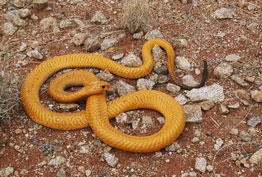
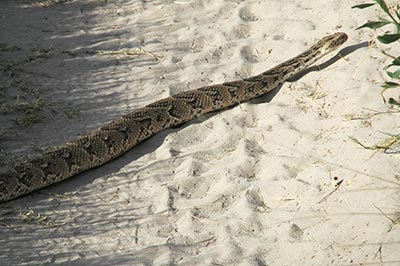
At Savuti camp there seemed to be elephants everywhere. The rule was, give them room, if they come into camp get in your tent. Not that an elephant couldn't smash your tent flat with one step, but why would it want to? This seems to work, you aren't food and the tent isn't moving, not a threat, so they just walk around it. There were elephant tracks just a few feet from the tent every morning, they can be very quiet as they tiptoe around camp at night. But this is a story about snakes, the elephants are just a distraction.
We were sitting at our Savuti Camp picnic table chopping up some vegetables for supper and thinking about elephants one night and left to go to the ablutions block (restrooms). When we came back Bushman guide Oakantsi showed us a Puff Adder track, which we followed to a spot under the table. Apparently it had crawled under there while we were busy setting up tents and liked the spot, so it just stayed. Like I said, you practically have to step on them to get them to strike. Oakantsi had removed the snake while we were away from the table. Hmm, 90 minutes. Even our guides were a bit rattled by this incident.
The snakes have an impact on star gazing. Somehow shining bright flashlights around the ground so as not to step on snakes isn't conducive to eyes adjusting to the starry sky. Like we said, it's amazing being in this land of serious wild animals.
AFRICA SIX - ELEPHANTS
Botswana is one country that doesn't support the ban on elephant ivory trade.
As one guidebook put it, one only has to go to northern Botswana so see why.
Elephants' trunks are plenty strong enough to grab an eight-inch trunk of an
acacia (or thorn bush) tree and break the tree trunk like a match stick to
get the uneaten leaves down to elephant height. When we were walking in the
bush with our mekoro guide Goldun we heard breaking trees and he said, "Hear
the elephants?" The Botswanan government would like to see the ivory trade
inspire some commercial culling of the herd. It seems there are too many elephants
for the land to sustain and in their effort to get enough food they destroy
the forests and rob the farms.
Chobe National Park along the Chobe River (a tributary of the Zambezi) provides the 65 gallons a day of water drunk by thousands of elephants.
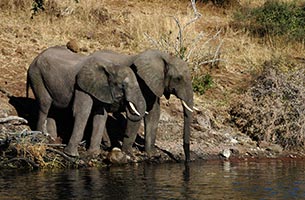
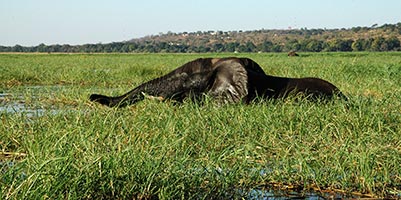
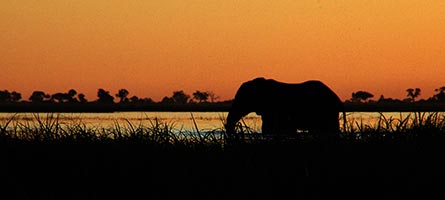
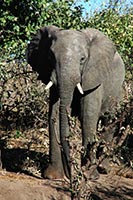
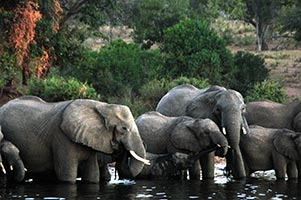
We were told that African elephants are less friendly and trainable than Indian ones and the elephants of circuses are usually Indian. One elephant we met was stomping a hole near the river bank, which filled with water. He stomped in it some more, creating quite the mud hole. Then he sprayed the water and mud over himself - to keep cool? a mud sunscreen? mud bath?
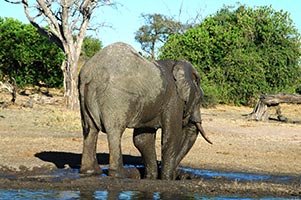
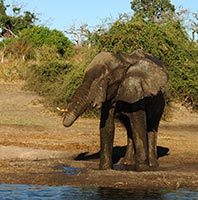
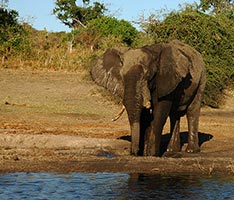
We went to bed and heard nothing other than the hyenas and honey badgers trying to get into our food during the night, but when we awoke in the morning we found that the elephants had been tiptoeing around the campsite through the night, leaving fresh tracks within 5-6 feet of our tent.
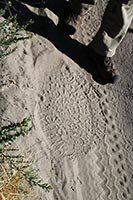
It seems that elephants are very picky about the water they drink if they have that option. They would prefer what the Africans called "sweet water", (I suppose we would call it "fresh" or "purified") over what is in the water holes. And they can smell the quality of the water. There in the Savuti campground the elephants have completely destroyed the shower and toilet facilities including digging up the water pipes numerous times. The last time it was rebuilt it looked more like a fortress than a national park bathroom. There was a multi-elephant-high cinder block fence and on the inside there was an earthen dam against the cinder blocks so the elephants couldn't push it over. The entrance to the facility was (again) several elephants high with an entryway just shoulder width, human shoulder that is. Just imagine being the engineer / architect who has to design an elephant-proof building - an unusual architectural assignment.
Of course one of the biggest draws of Africa for Max and I, lifelong musicians, is the music. Here's what we found.
Our first musical experience was with Alport Mhlanga who is one of the originators
and primary composers of the Zimbabwean marimba music we have played for the
last decade. Alport immigrated with his family to Gaborone 20 years ago and
now teaches music, including marimba, at the Maru-a-pula (Clouds of Rain) school
in Gaborone. We spend several delightful days with Alport, talking and playing
music, sharing our instruments, playing with and teaching his marimba band
a tune Max composed, and learning some of Alport's compositions. I returned
the favors with some music on my dulcimer.
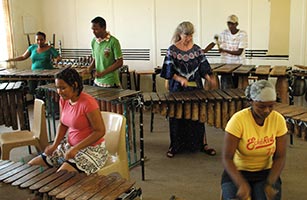
Next our bushmen guides showed us how the stems of certain grasses make quite
a musical sound when plucked. Being the musical guy that he is, Max picked
up music-making with grass right away!
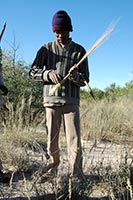
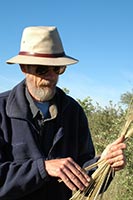
Like in many African countries there is a form of the "thumb piano" and
Botswana's is called a "setinkane." We ran into several players and
they played to us, and then Max played his Zimbabwean "mbira" in
return. There's also a mouth bow like the Appalachian one with which we are
familiar but we didn't catch the name. Again our musical whiz had it down in
no time to the delight of the village residents. There are "violins" made
of one string and a gallon size oil can, and instruments made with animal skin
like banjos.
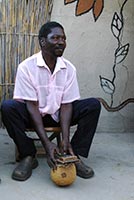
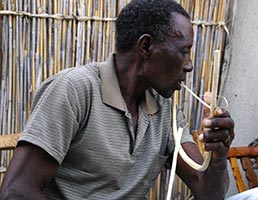
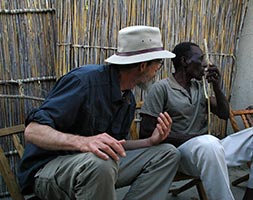
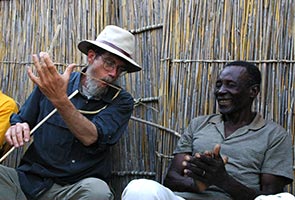
I guess it doesn't really get much more indigenous than
plucking grasses, but other Botswanan indigenous music making seemed to consist
of fast, even clapping while singing and dancing. We attended the rehearsal
of a singing / dance troupe in Gaborone who performed dances from many Botswanan
tribes - the dances dealt with harvesting, rain-making, hunting, and of course
courting. Here are two troupes we found in the north of the country who did
this sort of music and dance.
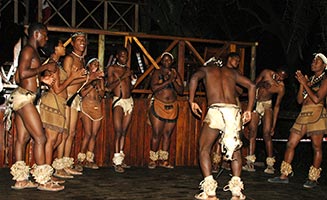
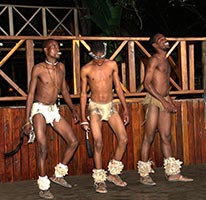
This one sang and danced on the street for tips in Victoria Falls, Zimbabwe
just like musicians do on the the downtown Boulder, Colorado mall. We talked
of the similarities of musicians lives everywhere.
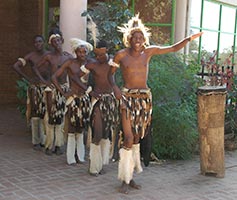
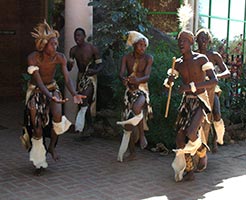
We made fast friends with a band named Sinsika who played also at Victoria
Falls. Their instruments came from the Kwanangoma School in Bulawayo, Zimbabwe
which is where the marimba music we play originated as well. They knew many
songs we knew and we played with them. I had some good conversations with Mthabisi,
the band leader - I asked him, "What do you think the future holds here
in Zimbabwe where everything is such a mess?" He replied, with a smile
- this guy was not going to let it get him down - "We have no future,
but lucky us musicians, we can play music and it's keeps us going." He
felt concerned about people who were not musicians. I wanted to learn to smile
like that - for the looks as well as for the feeling he expressed.
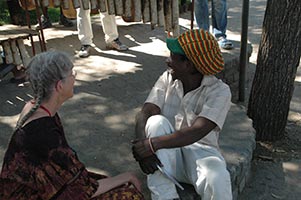
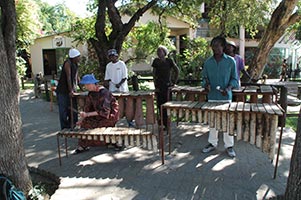
The myth is that everyone, literally everyone in Africa is musical - plays or sings or dances. We didn't find this to be the case - the situation seemed to be more or less like here - some people play and some don't think they are at all musical. Another thing we have in common with people all over the world. I guess all us humans have more similarities than we know!
Having seen some African lions in the wild, they are indeed the kings of the jungle, or in our case, the Kings of the Kalahari.
There is a variety of lions known as Kalahari Lions which have blackish manes and are uniquely adapted to do without water longer than most lions, an essential trait for survival in the Kalahari desert which is without permanent water sources. Most of the animals in Botswana need to migrate from water hole to water hole as the rains fall here and then over there. Other than in the Okavango Delta and along the Chobe River (which joins the Zambezi near the border with Zimbabwe, there are no permanent water sources in the Kalahari desert which covers 85% of Botswana's land mass. It's difficult to find words for how central water is to everyone's thinking in Botswana - the monetary currency is named "pula" which means rain. There is a school in Gaborone named "Maru-a-pula" - clouds of rain. The topic of rain is on everyone's lips daily and many seasonal activities follow the absence and then the coming of rain.
What about the veterinary fences? sometimes called the buffalo fences? Here's what I heard: there are cattle everywhere - it's a main industry in Botswana. The European Union is a customer of Botswanan beef, but has put pressure on the beef industry to insure that hoof and mouth disease, carried by the wild water buffalo, doesn't contaminate the beef they buy. In order to sell beef to the EU, Botswana has fences that go hundreds of miles across the country to keep the buffalo and the domestic cattle apart. But what about the animals that need to migrate to get water, you may ask? They die in great numbers because they can't get to the seasonal water holes. So the buffalo fences are at best a mixed bag.
Our first encounter with lions was at dinnertime one night when our Bushman guide said, "Hear the lions?' He had told us lions could be heard from as far as five miles, but these sounded like they were a couple hundred yards from camp. We watched carefully to see if anyone was going to run for the car. No one did. Everyone calmly continued eating dinner and went to tents for sleeping. The lions roared all night, and I recorded them with my mini-disc recorder.
In the morning the Bushman guide took us on a "lion hunt". He found the tracks of two big male lions, and the place where they fought over the female whose tracks were near by. The Bushmen showed us where the lions had marked shrubs and left some hairs on the bushes as they scuffled. We wanted to keep a few of the 4-5 hairs, but the Bushmen needed them to insure luck on their next hunt. We asked if the Bushmen had been frightened by the lions the night before and they assured us the lions were much more interested in Ms. Lion than in us. We didn't see these lions, only their tracks.
Our next lion encounter happened in the Savuti Marsh area, one of the National Parks. We were told by the park rangers that there were a couple of lions in the area. One safari wagon found a lion in the early evening, and all the other 4-5 wagons in the area were alerted by radio and came to see it. We watched while it lolled in the grass, yawning and being uninhibited by the presence of 30-40 people and four safari wagons 40 feet away. After a few minutes, along came a warthog, and we anticipated a chase. "Our" lion jumped up, and as if from no-where, another jumped up and they were lackadaisically chasing the warthog together. No serious hunting going on, just keeping the warthog on his toes. They chased for half a minute then lay down in another patch of grass where they totally disappeared! Made us a little reluctant to walk any more through what one of our guides called "lion grass." It's called this because if a lion were there, you certainly couldn't see if, he said. Very true we thought after watching these two disappear into the grass.
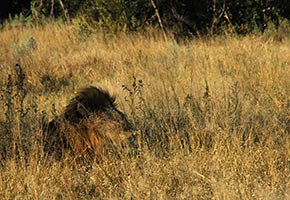
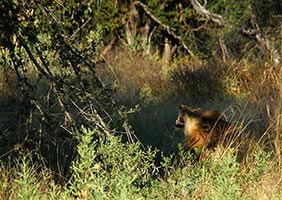
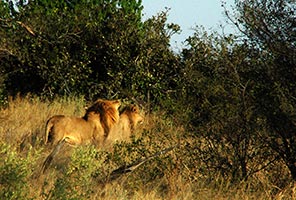
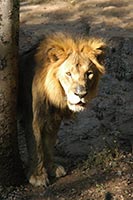
In Victoria Falls, Zimbabwe, we visited a Nature Preserve / Animal care facility / Croc Farm and learned many interesting facts about lions from our humorous and very knowledgeable guide, Tulani. Here's what he told us: lions live about 10 years in the wild. A male lion has access to females for only a couple of years of the ten years and otherwise is on his own or with some brothers. These male groups do their own hunting, thus dispelling the myth that only the female lions hunt. When a young male lion defeats an older one and takes over the pride of several females, none of the females go into heat for six months. This is a trial period for the new male. If the females like him, they will become amorous. A pair will mate 3-4000 times in several days, Tulani said. It's difficult to get the females pregnant, he said. The lion who lived at the Conservancy was but a chain link fence away from us and when we came by, Shumba (that was really his name) came to the fence and poked his toes through. Tulani nudged his toes and Shumba responded verbally with something akin to a snicker. Only it was really LOUD - I can image that it is indeed earth-shattering and can be heard for 5 miles indeed when Shumba really gets roaring! What a voice!
Like in Boulder, the lions follow the tasty antelope / deer-like creatures. Wherever there is other game, there is a pride of lions or two.
I'll never feel the same about Metro-Goldwyn-Mayer's logo lion roaring!
Here's a very amazing you-tube video about lions hunting in Krueger National Park in South Africa: http://www.youtube.com/watch?v=LU8DDYz68kM